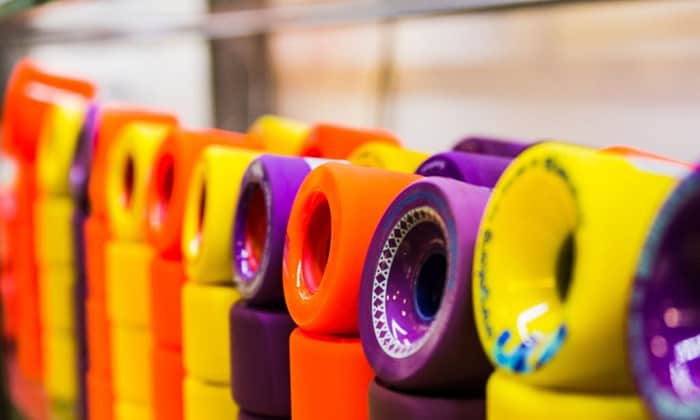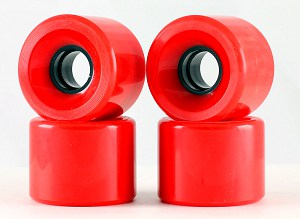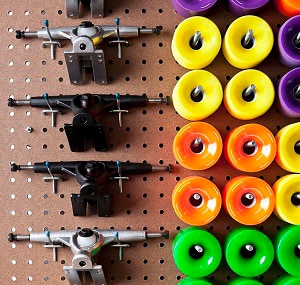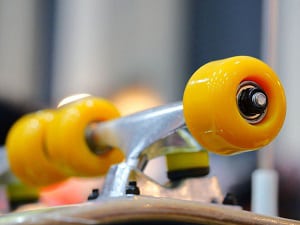The cost of getting a skateboard isn’t the only amount you should spend to enjoy the sport. Skating also requires buying safety gear and replacement parts. And of these parts, the most costly ones include the trucks and wheels.
So, if you happen to be changing your first wheels, do you already know what to consider? If not, don’t worry. Let me talk about the different types of skateboard wheels and a short skateboard wheels guide to help you pick the best replacements for your board.
Table of Contents
Skateboard Wheel Types
If we only choose good skateboarding wheels based on their ability to roll, we’ll miss out on quality rides more often than not. Here are the skate roller types you should remember.
1. Park and street wheels
Skateboard wheels for street skating and parks are generally light, making them fast and smooth on paved surfaces. These are excellent on concrete and coping.
2. Skateboard cruiser wheels
Cruisers, or filmer wheels, also roll fast like the previous type. But what sets these wheels apart is their ability to glide smoothly on rough surfaces. They are also adept at absorbing vibrations on the road.
3. Longboard wheels
Longboard wheels know no sharp corners with their high grip. There are different longboard wheel types. Straight-edged ones, in particular, are perfect for speed racing and downhill skating.
Size and Hardness
Let’s get to know more about these three primary skate wheel types through the following aspects:
1. Size
Like decks, wheels should also be of the ideal size to match your skating style. And for this part, we use diameter to quantify the wheel’s dimensions. Here is a short size description of the three different skateboard wheels.
- Park and street – 50mm to 60mm
- Cruiser – 54mm to 60mm
- Longboard – 60mm to 75mm
Friendly note: Wheels with a size ranging from 52mm to 54mm are ideal for beginners.
2. Hardness
The wheel’s bounce, grip, and riding smoothness depend on how hard it is. The durometer is the scale used to measure the hardness rating of skateboard wheels. Let’s get into three primary hardness scales.
- Park and street – 95a to 101a
- Cruiser – 78a to 90a
- Longboard – 75a to 85a
This time, let’s see what the numbers and measurements indicate. Also, we’ll explore other wheel features you should consider.
Diameter
Given the sizes of the three types, each range has its advantage. Those in the smallest group are also the least in weight. Such an aspect helps the skateboard obtain a better pop.
The bigger wheels are fit for the added challenge of rough roads. While these rollers are heavier, they are still fast-moving and ignorant of road debris.
Durometer
Lower durometer skateboard wheels are softer. Those with durometer levels around 99a are the hardest and are ideal wheels for skateboard tricks.
On the other hand, the soft ones work best for longboards and cruiser boards.
Wheel contact patch
How much wheel surface makes contact against the ground is also a significant consideration. Note that the contact patch may not relate directly to the numbered aspects.
The concept for this aspect is simple. Broad contact patches allow better weight distribution and less instability. Conversely, narrow contact surfaces enable more convenient slides and trick execution.
Wheel profile
The wheel profile is the lining between the contact patch and the wheel’s sidewalls. This part, also called lip radius, comes in two types: sharp and rounded.
Round-lipped tires for skateboard are those in action on parks and the streets. Often, these are sought-after wheels by skaters who ride on obstacles. On the other hand, the wheel with sharp lips makes cruising and longboarding feel like a walk in the park.
Wheel shape
The wheel’s sidewall could have a curved or coned shape. These differences affect the roller’s grip, weight, and locking ability.
There are four popular wheel shapes we should know about: classic, wide, narrow, and conical.
Classic-shaped wheels are bouncy, fast, and grippy. Often, they’re present on cruiser skateboards. Wide skateboard rollers are also speedy, but they move better in skateparks and on bowls.
The third type is the narrow shape. These wheels have little contact patches, making them perfect for technical skating. Last is the conical wheels or rollers that fit both streets and tricks.
Frequently Asked Questions
Can you use longboard wheels on a regular skateboard?
Yes! But that doesn’t guarantee a quality ride every time. Remember that shortboards have technical skating-ready structures. Thus, equipping them with longboard wheels imposes limitations.
If you ever decide to use such a wheel type on a skateboard, note down these things:
- Use risers to avoid wheel bite
- Tighten your trucks
- Soft bushings are not your friend
- Don’t go over 70mm in size
Hard wheels VS soft skateboard wheels
Whether you pick hard or soft wheels for skateboarding, both yield good results.
Using hard rollers on your skateboard will let you perform tricks, stunts, and other forms of technical skating. These wheels are responsive enough to make your moves more agile on the skateboard.
Conversely, soft skate wheels are for comfort. They have a plushy structure that makes them fit for rough roads and capable of rolling over debris as smoothly as possible.
Small skateboard wheels VS large wheels
Large skateboard wheels are efficient for keeping speed and momentum. However, they would need constant pushing to accelerate better. And if using rollers bigger than 56mm, skaters should install spacers below the deck.
Meanwhile, small wheels are helpful for technical skating. Versus the previous type, these rollers are easier to maneuver on rails and ledges.
Conclusion
Skateboard wheels link the skateboard to the ground. And they are the last receivers of the skater’s movements. Thus, they should meet the appropriate configurations based on your style and riding environment to help you achieve great rides.
Now that you know the different types of skateboard wheels, you can finally be sure of the primary setup to choose for your boards. And when picking, remember other pertinent factors to make the process more holistic and effective.
Get ready for quality skate rides with the best wheels in town!

Hi, I am Charles Harris. I opened this site to write as much as I can about my biggest passion – skateboarding!
I started as a clumsy yet passionate rookie 10 years ago to now a still passionate yet much better skateboarder! But I have to tell you, the whole journey has always been fun and rewarding, indeed not without hardship.





